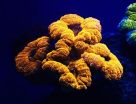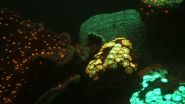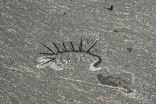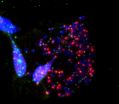INFORMATION:
Full details of the research appear in: Spectral Diversity and Regulation of Coral Fluorescence in a Mesophotic Reef Habitat in the Red Sea Eyal G, Wiedenmann J, Grinblat M, D'Angelo C, Kramarsky-Winter E, Treibitz T, et al. (2015). PLOS ONE 10(6): e0128697. doi:10.1371/journal.pone.0128697
Further references
Gittins, J. R., D'Angelo, C., Oswald, F., Edwards, R. J. and Wiedenmann, J. (2015), Fluorescent protein mediated colour polymorphism in reef corals: multicopy genes extend the adaptation/acclimatization potential to variable light environments. Mol Ecol, 24: 453-465. doi:10.1111/mec.13041. Free download: http://onlinelibrary.wiley.com/doi/10.1111/mec.13041/pdf
D'Angelo, C., E.G. Smith, F. Oswald, J. Burt, D. Tchernov and J. Wiedenmann. "Locally Accelerated Growth Is Part of the Innate Immune Response and Repair Mechanisms in Reef-Building Corals as Detected by Green Fluorescent Protein (Gfp)-Like Pigments." Coral Reefs 31, no. 4 (2012): 1045-1056.
Free download: http://link.springer.com/article/10.1007%2Fs00338-012-0926-8
Wong, C.K., Laos, A.J., Soeriyadi, A.H., Wiedenmann, J., Paul, M.G., Curmi, P.M.G, Gooding, J.J. et al. "Polymersomes Prepared from Thermoresponsive Fluorescent Protein-Polymer Bioconjugates: Capture of and Report on Drug and Protein Payloads." Angewandte Chemie 127, no. 18 (2015): 5407-5412.
http://onlinelibrary.wiley.com/doi/10.1002/ange.201412406/abstract
Notes for editors
1. Photos and video available via link: https://www.dropbox.com/sh/ihsrdumqijp5hrd/AADt7ESMzUBsTQQvSvx4t1hEa?dl=0 (See titles for captioning)
Credit: Prof. Jörg Wiedenmann
2. For a copy of the paper Spectral Diversity and Regulation of Coral Fluorescence in a Mesophotic Reef Habitat in the Red Sea Eyal G, Wiedenmann J, Grinblat M, D'Angelo C, Kramarsky-Winter E, Treibitz T, et al. (2015) PLOS ONE 10(6): e0128697. doi:10.1371/journal.pone.0128697 please contact Steven Williams, Media Relations, University of Southampton, Tel: 023 8059 2128, email: S.Williams@soton.ac.uk
3. For interview opportunities with Professor Wiedenmann, please contact media relations.
4. For more information about the Coral Reef Laboratory of the University of Southampton, based at the National Oceanography Centre Southampton: http://noc.ac.uk/corals
Prof. J. Wiedenmann: http://www.southampton.ac.uk/oes/research/staff/jw1w07.page
Dr. C. D'Angelo: http://www.southampton.ac.uk/oes/about/staff/cda1w07.page#background
For more information about other research projects at the Coral Reef Laboratory: http://www.southampton.ac.uk/oes/about/staff/jw1w07.page#research
https://www.youtube.com/watch?v=fAoIkM00FAQ
Follow the Coral Reef Lab on Twitter: https://twitter.com/TheCoralReefLab
Like the Coral Reef Lab on Facebook: https://www.facebook.com/pages/Coral-Reef-Lab-NOC/234893246595342?sk=photos_stream
5. Ocean and Earth Science at the University of Southampton has reaffirmed its position as a world-leader in research excellence following publication of the national Research Excellence Framework 2014 (REF2014). http://www.southampton.ac.uk/oes/news/2014/12/ocean_and_earth_science_at_southampton_once_again_ranked_world_leading.page?
3. Through world-leading research and enterprise activities, the University of Southampton connects with businesses to create real-world solutions to global issues. Through its educational offering, it works with partners around the world to offer relevant, flexible education, which trains students for jobs not even thought of. This connectivity is what sets Southampton apart from the rest; we make connections and change the world. http://www.southampton.ac.uk/
http://www.southampton.ac.uk/weareconnected
For further information contact:
Steven Williams, Media Relations, University of Southampton, Tel: 023 8059 2128, email: S.Williams@soton.ac.uk
http://www.soton.ac.uk/mediacentre/
Follow us on twitter: http://twitter.com/unisouthampton
Like us on Facebook: http://www.facebook.com/unisouthampton
Rainbow of glowing corals discovered in depths of the Red Sea
New coral pigments could have use in biomedical imaging applications
2015-06-24
(Press-News.org) Glowing corals that display a surprising array of colours have been discovered in the deep water reefs of the Red Sea by scientists from the University of Southampton, UK, Tel Aviv University and the Interuniversity Institute for Marine Sciences (IUI), Israel, together with an international team of researchers.
The researchers, whose findings have been published online today in research journal PLOS ONE, hope that some of the coral pigments could be developed into new imaging tools for medical applications.
The team studied corals at depths of more than 50 metres and found that many of them glow brightly with fluorescent colours, ranging from green over yellow to red. The encounter of such a rainbow of coral colours in deep waters was unexpected, since their shallow-water counterparts in the same reef contain only green fluorescent pigments.
Jörg Wiedenmann, Professor of Biological Oceanography and Head of the University of Southampton's Coral Reef Laboratory, explains: "These fluorescent pigments are proteins. When they are illuminated with blue or ultraviolet light, they give back light of longer wavelengths, such as reds or greens.
"Their optical properties potentially make them important tools for biomedical imaging applications, as their fluorescent glow can be used to highlight living cells or cellular structures of interest under the microscope. They could also be applied to track cancer cells or as tools to screen for new drugs."
Gal Eyal, PhD candidate at the IUI, says: "Corals from these so-called mesophotic reefs are less well studied since they are beyond the depth limits of standard Scuba diving techniques. Advances in technical diving have enabled us to explore coral communities from these deeper waters.
"Since only the blue parts of the sunlight penetrate to depths greater than 50 metres, we were not expecting to see any red coloration around. To our surprise, we found a number of corals showing an intense green or orange glow. This could only be due to the presence of fluorescent pigments."
Such pigments are often found in shallow water corals, where they can act as sunscreens for the corals and their symbiotic algae. Finding them in depths where corals are struggling to collect enough light to sustain the photosynthesis of their algal symbionts (a vital energy source for the corals) is therefore unexpected.
Dr Cecilia D'Angelo, Senior Research Fellow at Southampton, has studied corals commonly found in mesophotic depths in the experimental aquarium of the University's Coral Reef Laboratory: "In many shallow water corals, the production of the pigments is tightly controlled by the amount and colour of the incidental light. In the majority of our deep water species, the pigment production is essentially independent from the light exposure of the coral animals.
"We found, however, that some of the pigments of these corals require violet light to switch from their nascent green colour to the red hue of the mature pigment. This is a particularly interesting property to develop markers for advanced microscopic imaging applications."
The team now are now exploring which other biological functions these fluorescent pigments may fulfil.
Substantial parts of the research were conducted during the International Mesophotic Workshop 2014 held at the IUI in Eilat. Dr Yossi Loya, Professor of Zoology at Tel Aviv University and organiser of the workshop, concludes: "This study clearly shows the potential of interdisciplinary and international collaborations. We are delighted that the workshop has opened up such exiting new research avenues."
ELSE PRESS RELEASES FROM THIS DATE:
Got acne? Lay off the B12
2015-06-24
Vitamin B12 tweaks how genes behave in the facial bacteria of some people who normally enjoy clear skin. The activity changes of the facial bacteria promote inflammation and lead to pimples.
By shedding light on one mechanism behind B12's role in acne, the UCLA finding may identify drug targets that lead to new treatments for acne.
Huiying Li, an assistant professor of molecular and medical pharmacology at the David Geffen School of Medicine at UCLA, and Dr. Noah Craft, a dermatologist at LA BioMed at Harbor-UCLA Medical Center, are available for interviews.
Science ...
DNA shed from head and neck tumors detected in blood and saliva
2015-06-24
On the hunt for better cancer screening tests, Johns Hopkins scientists led a proof of principle study that successfully identified tumor DNA shed into the blood and saliva of 93 patients with head and neck cancer. A report on the findings is published in the June 24 issue of Science Translational Medicine.
"We have shown that tumor DNA in the blood or saliva can successfully be measured for these cancers," says Nishant Agrawal, M.D., associate professor of otolaryngology -- head and neck surgery -- and of oncology at the Johns Hopkins University School of Medicine. "In ...
Scientists highlight the importance of nanoscale hybrid materials for noninvasive cancer diagnosis
2015-06-24
Various diagnostic imaging techniques are currently used for clinical imaging/disease diagnosis. The accuracy of diagnosis is mainly based on the type of energy used (such as X-ray, sound waves, photons and positrons) to derive the visual information, as well as the degree of spatial resolution (mesoscopic or microscopic) and the level of information that can be obtained (physiological, anatomical or molecular). Based on potential health hazards imposed by type of energy used, clinical imaging modalities can be broadly categorized as ionizing and non-ionizing modalities. ...
This week from AGU: Malaysian quake aftermath, Arctic sea ice predictions
2015-06-24
From AGU's blogs: Landslide-induced sediment production after the Sabah earthquake in Malaysia
The Mw=6.0 5 June 2015 Sabah earthquake in Malaysia, which killed 18 people in rockfalls on Mount Kinabalu, generated landslides that have released large volumes of sediment. The heavy tropical rainfall in Sabah means that this sediment is now starting to enter the river systems in the form of mudflows and sediment-rich flash floods. Dave Petley explores the aftermath of the Sabah earthquake in a new post on The Landslide Blog.
From Eos.org: Improving predictions of Arctic ...
Newly found ring of teeth uncovers what common ancestor of molting animals looked like
2015-06-24
A new study of an otherworldly creature from half a billion years ago - a worm-like animal with legs, spikes and a head difficult to distinguish from its tail - has definitively identified its head for the first time, and revealed a previously unknown ring of teeth and a pair of simple eyes. The results, published today in the journal Nature, have helped scientists reconstruct what the common ancestor of everything from tiny roundworms to huge lobsters might have looked like.
Researchers from the University of Cambridge, the Royal Ontario Museum and the University of ...
Targeting telomeres, the timekeepers of cells, could improve chemotherapy
2015-06-24
LA JOLLA--Telomeres, specialized ends of our chromosomes that dictate how long cells can continue to duplicate themselves, have long been studied for their links to the aging process and cancer. Now, a discovery at the Salk Institute shows that telomeres may be more central than previously thought to a self-destruct program in cells that prevents tumors, a function that could potentially be exploited to improve cancer therapies.
When cells replicate in a process called mitosis, their telomeres get a little shorter each time. Eventually, after many cell divisions, telomeres ...
Giant comet-like tail discovered on small exoplanet
2015-06-24
The prospect of finding ocean-bearing exoplanets has been boosted, thanks to a pioneering new study.
An international team of scientists, including from the University of Exeter, has discovered an immense cloud of hydrogen escaping from a Neptune-sized exoplanet.
Such a phenomena not only helps explain the formation of hot and rocky 'super-earths', but also may potentially act as a signal for detecting extrasolar oceans. Scientists also believe they can use the discovery to envisage the future of Earth's atmosphere, four billion years from today.
The ground-breaking ...
NIFA grant aims to assure food safety in urban gardens of Detroit
2015-06-24
DETROIT - Urban gardens are becoming more commonplace across Detroit and other major urban cities throughout the United States. These gardens offer a source of free or inexpensive healthy food for the public and educate community members about food production and rehabilitating the local ecosystem. The revolution of urban agriculture has the potential to address many economic, environmental and personal health issues.
With urban agriculture gaining popularity for improving local and sustainable food systems, the question of food safety has become a growing concern. To ...
2014 Impact Factor release shows the influence of content published by Portland Press
2015-06-24
The Impact Factors and journal metrics for the range of molecular bioscience journals published by Portland Press, the knowledge hub for life sciences, have been announced. The 2015 Release of Journal Citation Reports® (Source: 2014 Web of ScienceTM Data) shows an increase in article influence scores indicating that the research being published and cited in Portland Press journals carries influence scores above the average in its field.
The announcement of these metrics comes in the middle of an exciting year for Portland Press. Having just migrated all its journals ...
Study examines cesarean section delivery and autism spectrum disorder
2015-06-24
The initial results of a study suggested that children born by cesarean section were 21 percent more likely to be diagnosed with autism spectrum disorder but that association did not hold up in further analysis of sibling pairs, implying the initial association was not causal and was more likely due to unknown genetic or environmental factors, according to an article published online by JAMA Psychiatry.
Autism spectrum disorder (ASD) is thought to affect about 0.62 percent of children worldwide, although estimates in the United States have been closer to 1.5 percent. ...
LAST 30 PRESS RELEASES:
SwRI upgrades nuclear magnetic resonance laboratory for pharmaceutical R&D
House sparrows in northern Norway can help us save other endangered animals
Crohn's & Colitis Foundation survey reveals more than 1/3 of young adults with IBD face step therapy insurance barriers
Tethered UAV autonomous knotting on environmental structures for transport
Decentralized social media platforms unlock authentic consumer feedback
American Pediatric Society announces Vanderbilt University School of Medicine as host institution for APS Howland Visiting Professor Program
Scientists discover first method to safely back up quantum information
A role for orange pigments in birds and human redheads
Pathways to net-zero greenhouse gas emissions for Southeast Asia
A JBNU–KIMS collaborative study on a cost-effective alloy matches superalloys for power plants and energy infrastructure
New study overturns long-held model of how plants coordinate immune responses.
New AI model predicts disease risk while you sleep
Scientists discover molecular ‘reshuffle’ and crack an 80-year-old conundrum
How stressors during pregnancy impact the developing fetal brain
Electrons lag behind the nucleus
From fungi to brain cells: one scientist's winding path reveals how epigenomics shapes neural destiny
Schizophrenia and osteoporosis share 195 genetic loci, highlighting unexpected biological bridges between brain and bone
Schizophrenia-linked genetic variant renders key brain receptor completely unresponsive to both natural and therapeutic compounds
Innovative review reveals overlooked complexity in cellular energy sensor's dual roles in Alzheimer's disease
Autism research reframed: Why heterogeneity is the data, not the noise
Brazil's genetic treasure trove: supercentenarians reveal secrets of extreme human longevity
The (metabolic) cost of life
CFRI special issue call for papers: New Frontiers in Sustainable Finance
HKU Engineering scholar demonstrates the smallest all-printed infrared photodetectors to date
Precision empowerment for brain "eavesdropping": CAS team develops triple-electrode integrated functional electrode for simultaneous monitoring of neural signals and chemical transmitters during sleep
Single-capillary endothelial dysfunction resolved by optoacoustic mesoscopy
HKU three research projects named among ‘Top 10 Innovation & Technology News in Hong Kong 2025’ showcasing excellence in research and technology transfer
NLRSeek: A reannotation-based pipeline for mining missing NLR genes in sequenced genomes
A strand and whole genome duplication–aware collinear gene identification tool
Light storage in light cages: A revolutionary approach to on-chip quantum memories
[Press-News.org] Rainbow of glowing corals discovered in depths of the Red SeaNew coral pigments could have use in biomedical imaging applications





